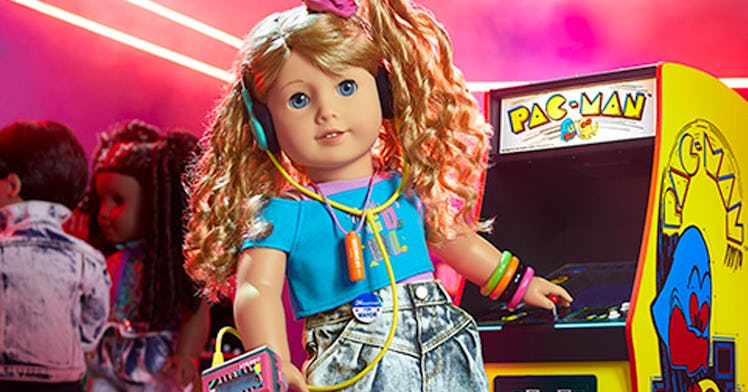New “Historic” 1980’s American Girls Doll Is the Black Mirror of Real Toy
What happens when you buy your kid a historic doll that could've been you friend?

Wanna feel old? The 1980s, a decade you most likely personally experienced, happened long enough ago to warrant a tribute in the form of an American Girl doll. But is this doll a toy that represents the real ’80s, or is it more of a funhouse mirror version of the “eighties” à la “San Junipero” from Black Mirror?
Courtney Moore, the character, is a tech-loving ’80s girl growing up as part of a blended family. She spends her time at the arcade at the mall in her fictional California town, and her heroes include her mom (who’s running for mayor) and the astronauts of the Challenger, which counted two women among its final, doomed crew.
Courtney Moore, the doll has all of the fashion hallmarks of the era: big hair that can be put into a side ponytail, Lip Smacker lip gloss, a hip-mounted cassette player, bangle bracelets, high-waisted denim skirt, one-shoulder neon crop top, fake leather boots, and absolutely zero evidence she doesn’t live in a virtual reality construct of the ’80s from Ready Player One.
That Courtney has her own American Girl doll is emblematic of what sets her apart from every American Girl doll that comes before. She is of an era in which American Girl dolls about previous eras in American history exist. Will the American Girl doll made about a girl in 2020, when it comes out in 2050, include a miniature American Girl doll (Courtney) with an even more miniature American Girl doll (Molly)? Whoa!
But the even weirder weirdness is that many of the parents who might buy Courtney for their kids lived through the ’80s. They wore similar outfits, participated in the same fads, and remember the Challenger disaster, the kind of tragic event that you remember where you were when it happened.
Unfortunately for American Girl and its acolytes, the fact that their original fans can now compare the history taught by the dolls to the times they actually lived through reveals the limitations of the entire enterprise as an authentic representation of the past.
Case in point: Courtney’s love of tech can’t be separated from 21st-century parents’ obsession with STEM. An ahistorical consideration, then, has clearly permeated the historical raison d’etre of the dolls.
But the strongest evidence that Courtney is just masquerading as a historical toy is the version of the ’80s she presents. It’s a reduction of the decade to trends and one event that the very adults who are buying this doll for their kids know doesn’t really capture the way things were.
Courtney’s shortcomings aren’t unique to her, but they do bring the weaknesses of the version of history presented by all of the brand’s dolls to light. Parents who know the ’80s were more than Courtney’s story can’t help but wonder what Felicity’s story leaves out about the American Revolution, what Addy’s story leaves out about slavery, and what Kit’s story leaves out about the Great Depression, for instance.
Here’s the bottom line. If you’re a parent who lived through a period in history, isn’t the best way to teach it talking to your kid about it? Until American Girl can produce a doll that tells stories better than parents can, the company is probably better off taking cover in more remote eras of history.
Because while that hypothetical 2050 doll that comes with a laptop running Zoom, Yeezys, and an N95 mask might not be historically inaccurate, it’s certainly not sufficient to teach kids about what it was really like to live through the disaster that is this year.
This article was originally published on